Physical Address
304 North Cardinal St.
Dorchester Center, MA 02124
In the modern era, combat trauma care frequently involves the management of major torso injuries that would have been rapidly fatal in previous conflicts. In addition to the severe wounds and altered physiology, surgical teams are increasingly required to resuscitate patients and operate in a variety of austere forward settings with significant limitations in personnel and equipment, particularly in the early or “immature” phases of any combat action ( Fig. 1 ). A more detailed overview of the current military medical system in the forward deployed setting is provided elsewhere (Field Triage in the Military Arena). The purpose of this chapter is to focus on the unique issues and management strategies for patients with major torso trauma (chest, abdomen, or combined thoracoabdominal) in a combat environment. Throughout history, lessons learned from the treatment of wartime wounds have helped to advance and refine global trauma care, with a resultant major decline in the risk of death from battlefield torso injuries. However, improved protective equipment, prehospital care, and transport times have resulted in an increase in the number of severely injured patients who survive to presentation at a forward medical facility. The modern combat surgeon must have a rapid and organized approach to the evaluation and early management of patients with major torso trauma, as any delays or errors can result in major morbidity or fatality.
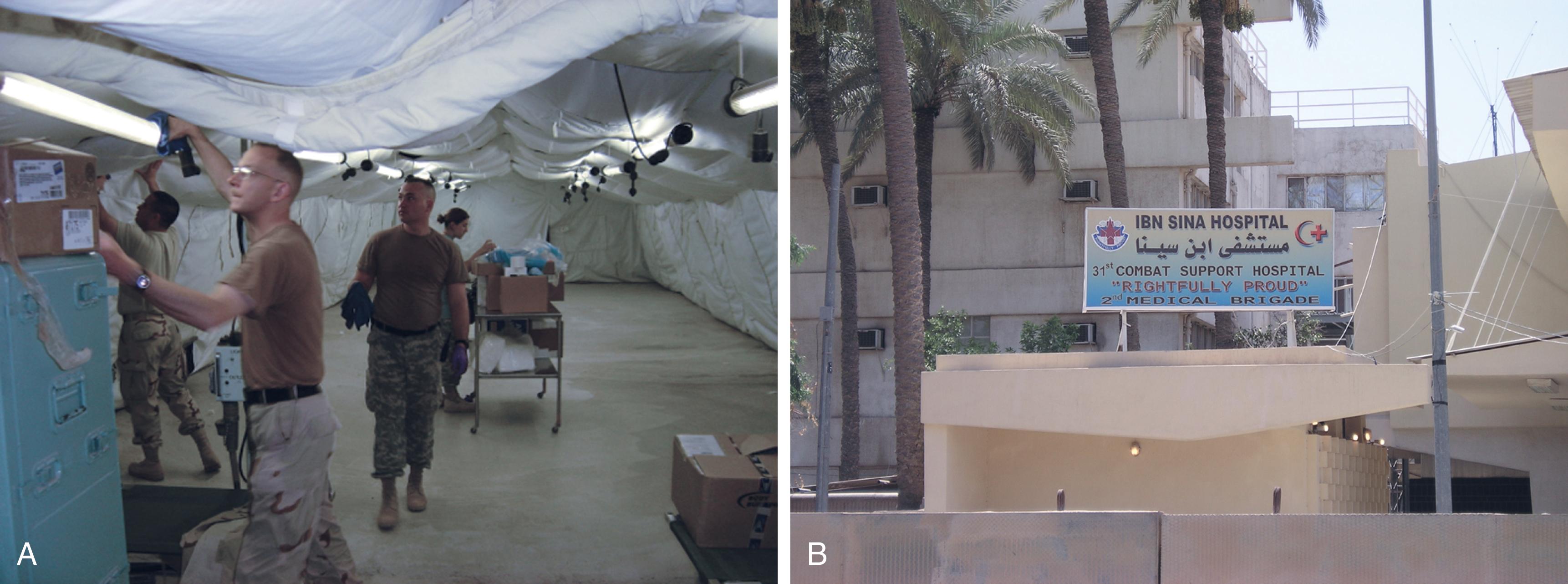
The true incidence of traumatic injuries during wartime is difficult to ascertain due to the complexities of collecting robust and complete clinical data in the operational environment. Most of what is currently known and published comes from analysis limited to U.S. facilities and military personnel and does not account for the massive numbers of nonmilitary personnel injured and often treated at local national or coalition medical facilities. Data from an analysis of 3102 combat casualties in the Joint Theater Trauma Registry (JTTR) found an incidence of 6% for thoracic injuries and 11% for abdominal wounds. A subsequent analysis of all injuries from 2001 through 2009 in the JTTR (unpublished data) has demonstrated an overall 15% incidence of truncal wounds. Table 1 demonstrates the percentage of wounds by body region with comparison with previous conflicts. The significant decline in major thoracic wounds in the current conflicts is likely attributable to improved personal protective equipment and vehicles. Despite the decline in incidence, the importance of rapid treatment of these injuries is highlighted by data indicating that approximately 50% of all deaths among patients with potentially survivable wounds are attributable to noncompressible hemorrhage from torso wounds. It is also important to remember that although the incidence of torso injuries has declined among wounded soldiers, it will remain significantly higher among civilian casualties or combatants who do not possess body armor or other protective gear. The unique severity and nature of combat wounds, particularly torso wounds, prompted efforts to develop a military-specific version of the widely used Injury Severity Score (ISS). The military ISS (mISS) has now been validated in a large military trauma registry study and found to have superior sensitivity and predictive ability compared to the standard civilian ISS.
| Body Region | World War II | Vietnam | OIF and OEF |
|---|---|---|---|
| Head and neck | 21 | 16 | 30 |
| Thorax | 14 | 13 | 6 |
| Abdomen | 8 | 9 | 9 |
| Extremities | 58 | 61 | 55 |
Active bleeding from abdominal or thoracic structures carries a high associated mortality rate, accounting for 60% to 70% of potentially preventable deaths in the civilian setting and 80% in the combat setting. Although the problem of “noncompressible” hemorrhage has long been recognized in combat settings, detailed study of the problem has been limited by the lack of any widely accepted definition or classification/scoring system. However, a recently published analysis that focused on hemorrhage and combat torso injuries describes the development of a set of diagnostic and classification criteria for noncompressible torso hemorrhage (NCTH) that are shown in Table 2 . Using these definitions, 13% of battlefield casualties met anatomic criteria and 2% were identified as having NCTH. The most lethal of these patterns was injury to a named torso vessel (odds ratio [OR] for death of 3.4), which was present in 20% of NCTH cases, followed by thoracic cavity injury (OR 1.9) when compared with solid organ injury (SOI) OR 1.0) and pelvic injuries (0.8). A similar incidence of NCTH of around 2% has been demonstrated in civilian trauma, but with a higher prevalence of blunt traumatic mechanisms. Similar to combat statistics, NCTH accounts for a large percentage (45%-85%) of potentially preventable deaths from bleeding in civilian trauma centers. Unlike peripheral or junctional vascular trauma, these injuries are not amenable to direct compression or simple inflow occlusion (tourniquet) in the prehospital or emergency department (ED) phase, which has led to the Committee on Tactical Combat Casualty Care (CoTCCC) to introduce the concept of advanced resuscitative care to specifically address abdominopelvic NCTH prior to surgical hemorrhage control. Critical concepts or interventions for patients with NCTH are: (1) minimizing delays in transfer from ED to operating room (OR) (or direct to OR resuscitation), (2) permissive hypotension until vascular control is obtained, (3) whole blood resuscitation or “hemostatic” resuscitation with early use of plasma if utilizing component therapy, (4) temporary vascular control with aortic balloon occlusion for abdominopelvic NCTH, (5) procoagulant adjuncts such as tranexamic acid (TXA), (6) resuscitation prior to anesthesia induction in unstable patients to prevent cardiovascular collapse, and (7) use of damage control surgery techniques and intravascular shunts when indicated. Innovative work that could directly impact survival from NCTH is being done and includes optimizing the use of resuscitative endovascular balloon occlusion of the aorta (REBOA) to include titrated “partial” REBOA, and the development of pharmacologic metabolic or hormonal agents to induce a “prosurvival” phenotype that is more tolerant to severe hemorrhage.
| Anatomic | Physiologic | Relative Incidence (%) | Odds Ratio for Mortality |
|---|---|---|---|
| Thoracic cavity |
|
32 | 1.9 |
| Solid organ injury > grade 3 | 20 | 1.0 | |
| Named axial torso vessel | 20 | 3.4 | |
| Pelvic ring disruption | 15 | 0.80 |
Modern warfare is characterized by an ever-increasing array of sophisticated and lethal weaponry that can create wounds that are unlike anything that is seen in civilian trauma centers. Although penetrating missile wounds may be commonly seen at many urban trauma centers, the resultant injuries from these primarily low-velocity weapons often pale in comparison to the devastating tissue destruction associated with high-velocity military projectiles. However, the most striking difference is encountered when dealing with blast and explosive injuries in a combat setting. The resultant combination of primary blast injury, penetrating fragment wounds, blunt trauma (such as vehicular rollover), and thermal injury frequently results in severe multisystem wounds including multiple amputations or mangled extremities, head and neck wounds, and major torso injuries ( Fig. 2 ). In previous conflicts, these types of injuries were mainly seen with military explosive devices such as mortars, rockets, and landmines. The recent conflicts in Iraq and Afghanistan have been marked by insurgent type warfare, with the improvised explosive device (IED) evolving as the enemy forces’ weapon of choice. The predominant wounding mechanisms by anatomic area are shown in Figure 3 . This is in striking contrast to prior conflicts, when gunshot wounds played a much more significant role. However, high-velocity military weaponry also continues to play a major role and can similarly result in devastating and challenging wounds ( Fig. 4 ).
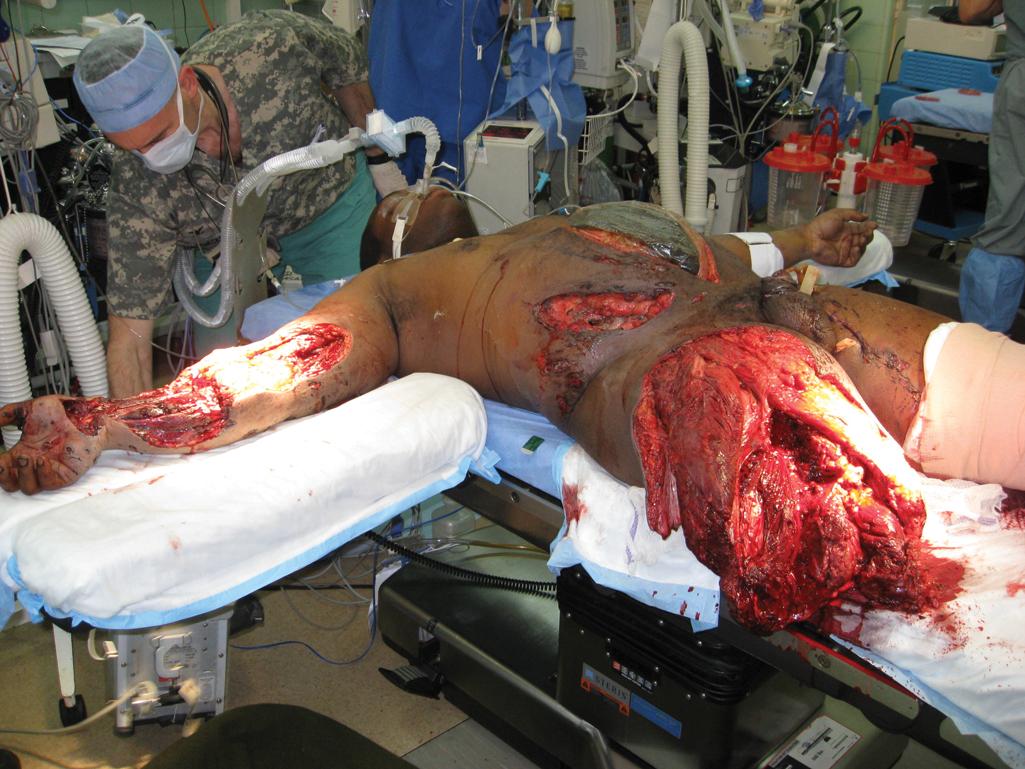
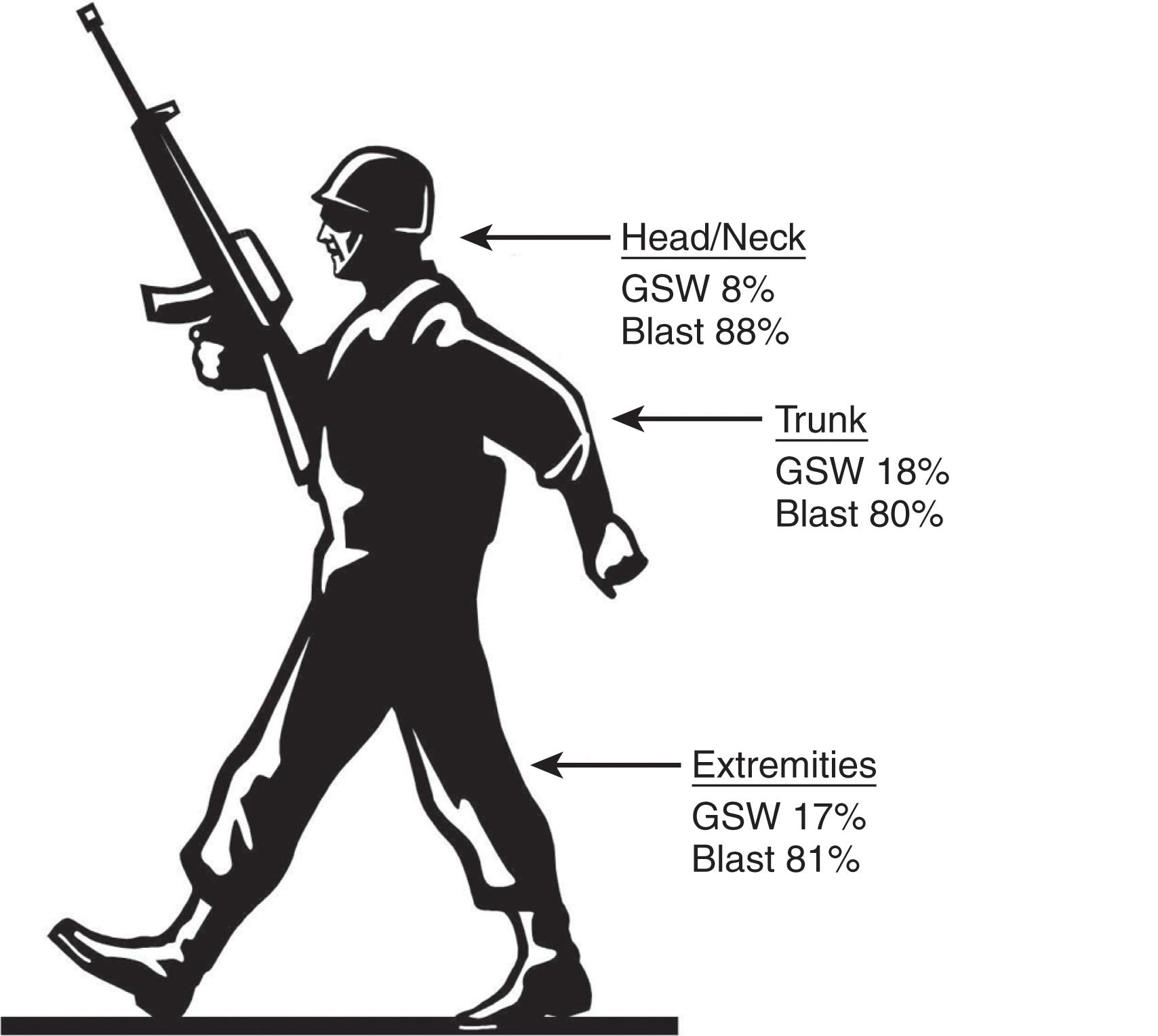
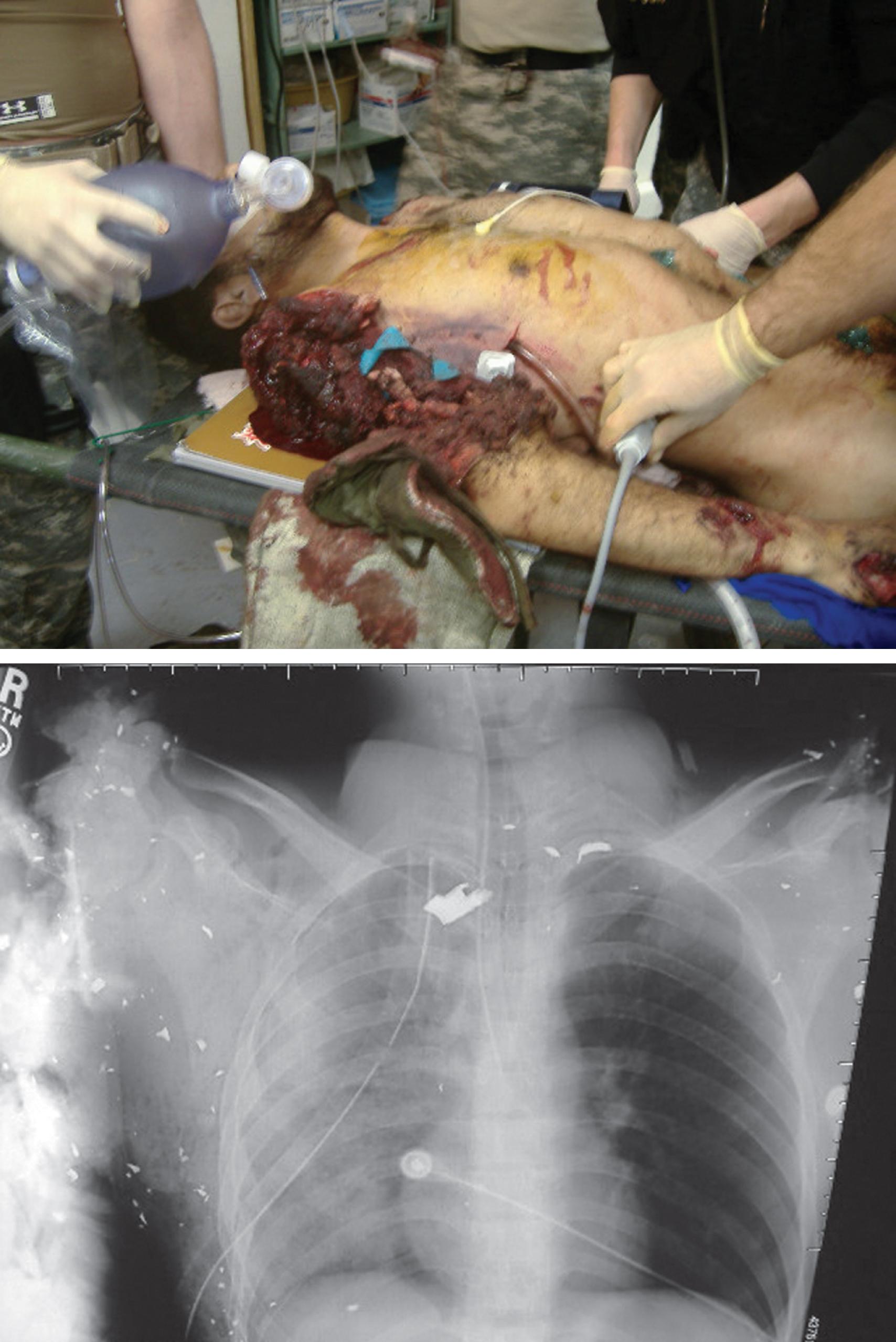
Two of the most important responses of the U.S. military to the IED threat have been (1) the development of hardened vehicles resistant to explosives and (2) improvements and widespread distribution of personal protective equipment that includes torso body armor, helmets, gloves, and eye protection. The most notable impact of these improvements has been on the incidence of truncal trauma, with a 50% reduction seen in the incidence of thoracic injuries compared with previous conflicts. In the authors’ experiences with multiple deployments to both Iraq and Afghanistan, this protective gear has frequently converted a fatal wounding mechanism to relatively minor and non-life-threatening injuries such as chest wall contusions or rib fractures ( Fig. 5 ).
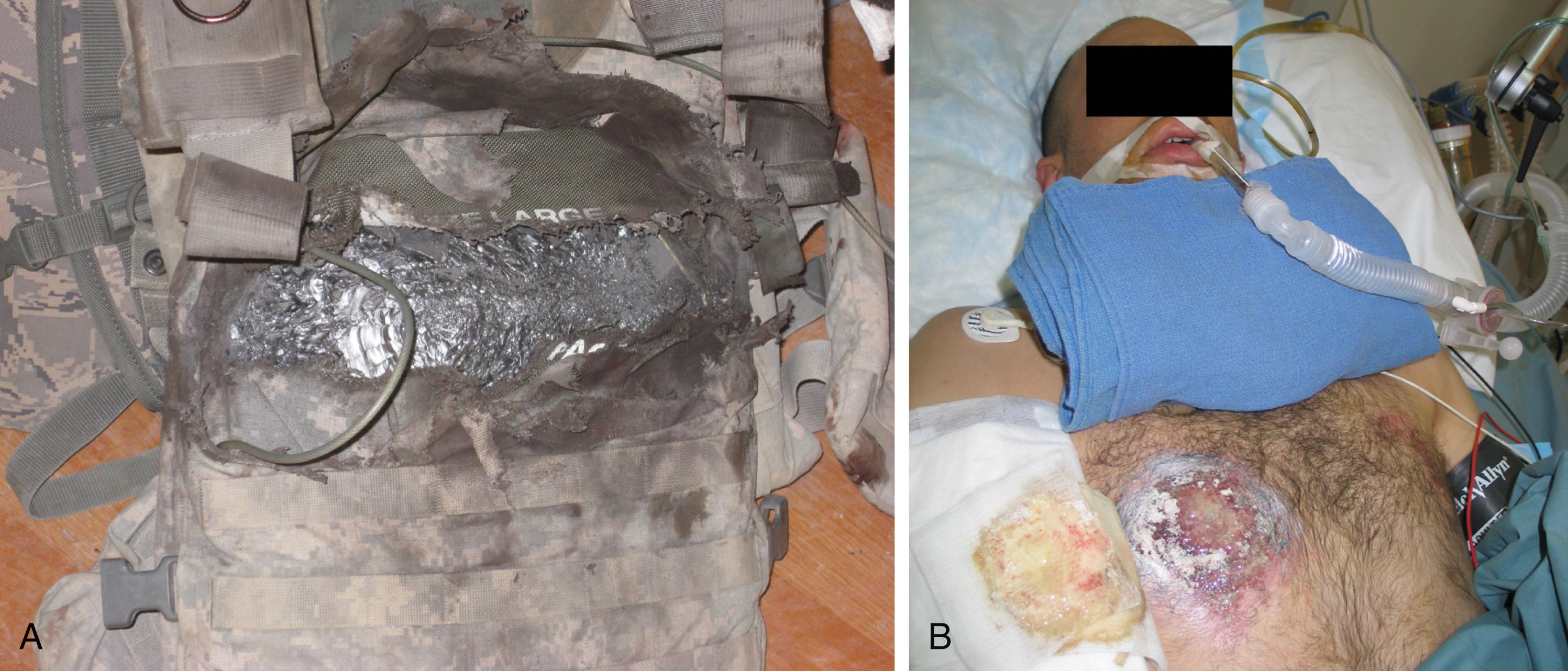
Initial evaluation of the combat casualty with truncal wounds must proceed in a rapid and orderly manner, often made difficult by the chaotic setting and severity of injuries. It is easy to become distracted by the presence of drastic-appearing (but non-life-threatening) extremity wounds; these should be ignored initially as long as they are hemostatic. Pneumothorax and noncompressible internal hemorrhage should be assumed in all patients until ruled out and must take priority. The combination of physical examination, chest radiograph or thoracic ultrasound, and abdominal/pericardial ultrasound can be performed in minutes and should identify any sources of major bleeding. Resuscitation with whole blood or balanced component therapy should begin immediately and simultaneously to the initial evaluation in combat casualties suspected of NCTH. Figure 6 shows an algorithm for truncal evaluation in these patients.
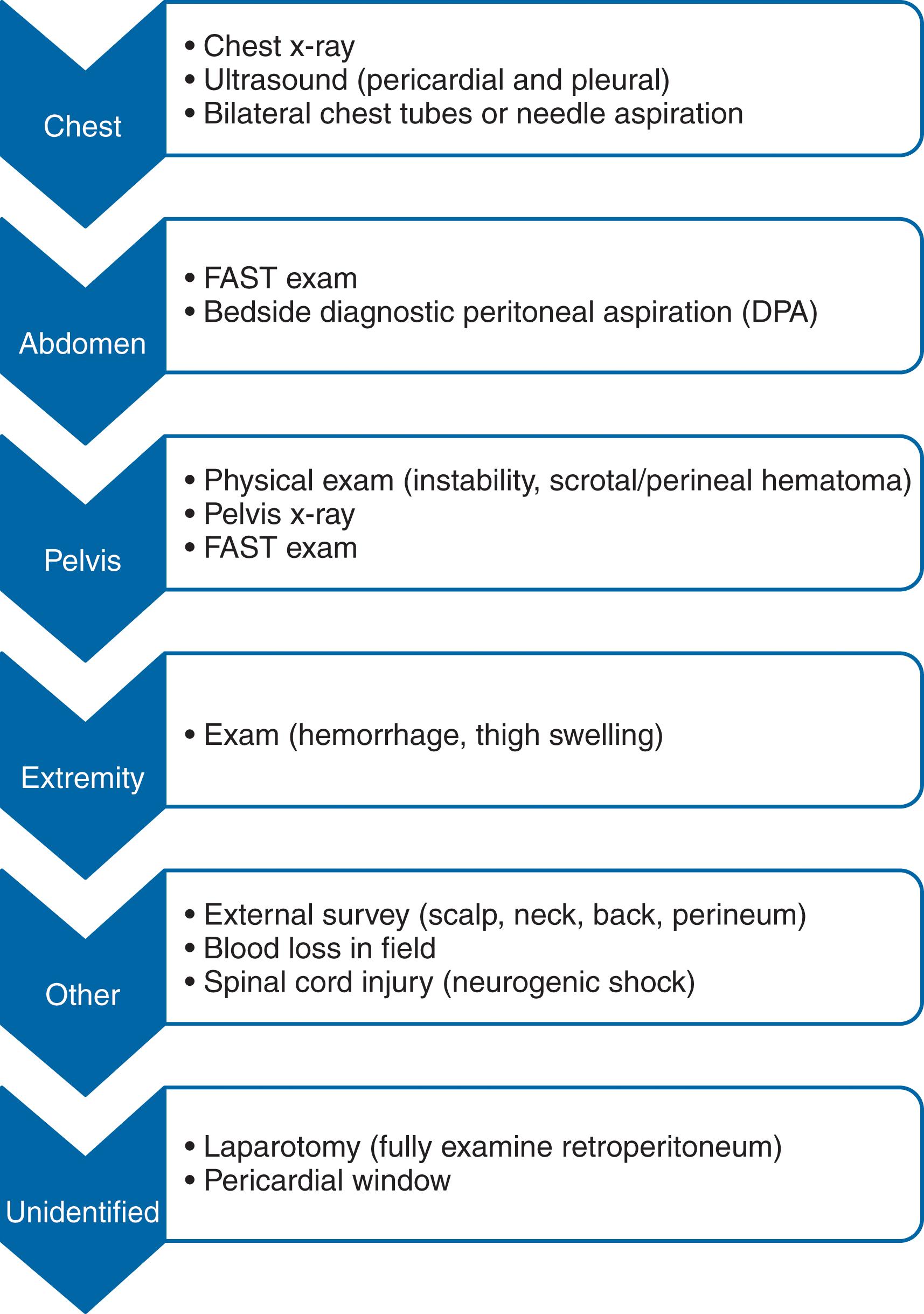
One of the most critical aspects of the early evaluation is avoiding early intubation in the emergency department prior to resuscitation. Several civilian studies are starting to define what experienced trauma surgeons already know: intubation prior to resuscitation can lead to disaster, particularly in the most unstable patients in hemorrhagic shock. Avoid the temptation to “control” the patient by early intubation in the emergency department if it is not specifically indicated for profound hypoxia and/or airway obstruction. Vasodilatory medications including narcotics and sedatives should also be avoided in the combat trauma victim with signs of shock, and the current guidelines strongly favor liberal use of ketamine in this scenario. Most patients, even those with a Glasgow Coma Score less than 8, can be temporized and be appropriately oxygenated and ventilated with either supplemental oxygen or airway adjuncts and a bag-valve-mask. Several civilian studies have shown that early intubation in the emergency department in the sickest trauma patients is associated with an increased incidence of postintubation traumatic arrest. This is likely due to cardiac arrest related the loss of vascular tone associated with medications given during intubation. Paradoxically, the more severely injured patients are likely the most at risk of postintubation cardiac arrest; therefore, early resuscitation with whole blood or balanced component therapy is paramount. Waiting to intubate until the patient is in the operating room gives time for appropriate resuscitation, minimizes time between intubation and surgical hemorrhage control, and allows for hemodynamic monitoring and use of vasoactive medications in a more controlled setting. Furthermore, if vascular collapse does occur during intubation, the surgeon is in the optimal place to rapidly control hemorrhage.
Another critical aspect in the evaluation of NCTH is to avoid any delay or unnecessary imaging in the unstable patient, or the patient with clear indication for operative intervention. Much more liberal use of true “exploratory” operations is made in combat situations due to decreased availability of high-resolution imaging, higher likelihood of intracavitary injuries, and lack of ability to perform serial examinations and monitoring due to multiple casualties and the need for rapid evacuation to another facility. Although many of the forward deployed medical units do not have computed tomography (CT) scan capability, high-quality portable ultrasound devices are universally available and should be used liberally. With little additional training, a physician operator can reliably and rapidly evaluate for pneumothorax or hemothorax, tamponade, gross cardiac contractility, and volume status (vena cava size and respiratory variation). This technology has even been extended to the prehospital combat environment and may augment the rapid identification and treatment of potentially fatal injury, particularly pneumothoraces. If focused ultrasound evaluation of the torso is not available or equivocal for an abdominal bleeding source, another useful diagnostic tool is the diagnostic peritoneal aspirate (DPA). In a multisystem trauma patient who does not respond to initial resuscitation and an obvious bleeding source is not identified using focused ultrasound, blood or succus identified on DPA should mandate immediate exploratory laparotomy.
Become a Clinical Tree membership for Full access and enjoy Unlimited articles
If you are a member. Log in here